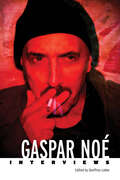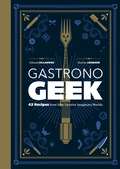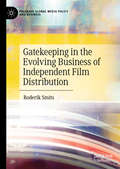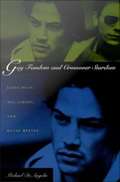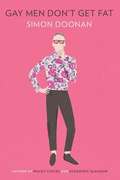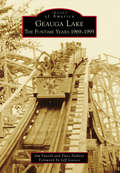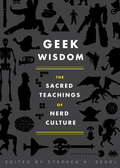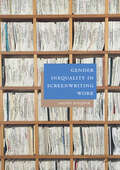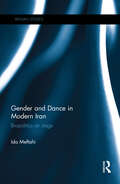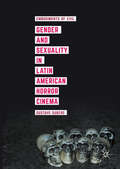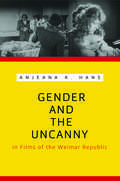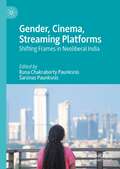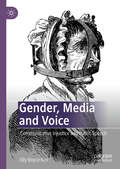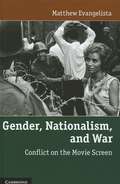- Table View
- List View
Gaspar Noé: Interviews (Conversations with Filmmakers Series)
by Geoffrey LokkeSince the release of his breakout film Irréversible in 2002, Gaspar Noé (b. 1963) has been labeled the principal provocateur of twenty-first-century French cinema. While many of the filmmaker’s complex and daring works have been reduced by his critics to their (innumerable) depictions of hallucinogens, violence, and unsimulated sexual intercourse—the latter rendered into vertiginous 3D with his film Love—other viewers have remained in steady awe of Noé’s dizzying camerawork, immersive visuality, and expressive editing. Noé’s cinema greets the short attention spans of digital life with works of extremities and endurance for performers and spectators alike. This first-of-its-kind collection of interviews documents Noé’s engagement with the feverish reception of his work and received ideas about his life and politics. Collecting conversations with critics, scholars, and artists, including fellow directors Matthew Barney, Abel Ferrara, and Harmony Korine, Noé speaks about his process as a writer, director, cinematographer, and editor. Also examined are his engagement with developing film technology and his fascination and indebtedness to past filmmakers such as Pier Paolo Pasolini, Jean Eustache, Stanley Kubrick, and Sam Peckinpah. Noé discusses life in Buenos Aires and emigrating to France, his use of irony and melodrama, and his interest in documentary practices. Throughout, Noé explores his continuing examination of faith and secularism, body and mind, and the politics of spectatorship. Editor Geoffrey Lokke’s introduction provides a close reading of Noé in conversation, assessing what has changed over the years in terms of the filmmaker’s aesthetics and presentation of self, as well as what Noé is reticent to articulate about his life and art.
Gasping for Airtime: Two Years in the Trenches of Saturday Night Live
by Jay MohrWhen 21-year-old Jay Mohr moved from New Jersey to New York City to pursue his dream of stand-up stardom, he never thought the first real job he'd land would be on Saturday Night Live. But, surprisingly, that's just what he did. What followed were two unbelievable, grueling, and exciting years of feverishly keeping pace with his talented cohorts, out-maneuvering the notorious vices that claimed the lives of other cast members, and struggling at all costs for the holy grail of late-night show business: airtime.In Gasping for Airtime, Jay offers an intimate account of the inner workings of Saturday Night Live. He also dishes on the guest hosts (John Travolta, Shannen Doherty, Charles Barkley), the musical guests (Kurt Cobain, Steven Tyler, Eric Clapton), and of course his SNL castmates (Chris Farley, Adam Sandler, Mike Myers, and David Spade). Refreshingly honest and laugh-out-loud funny, this book will appeal both to fans of Jay Mohr and to devotees of Saturday Night Live.
Gastronogeek: 42 Recipes from Your Favorite Imaginary Worlds
by Thibaud Villanova Maxime LéonardFrom Back to the Future to Superman, this cookbook combines gastronomy and geek culture with playful recipes from fifteen fandoms -- perfect for anyone looking to bring more magic and imagination into the kitchen.Presenting pop culture delicacies for both casual and devoted fans, this cookbook includes forty-two recipes to conjure up unbelievable three-course menus influenced by fifteen fandoms from science fiction, fantasy, manga, horror, and comics. Become a gourmet geek with this mouthwatering menu:A delicate "Impossible Soufflé" from Doctor Who"Sanji's Special Pork Steaks" from One PieceThe aptly named "Transylvanian Beef" from Dracula with roast beef, onions, and saffron potatoesA hearty "Vegetables of Yesteryear Pie" from The Lord of the RingsSpecialty sweets and desserts: "Martha Kent's Apricot and Almond Tart," "McFly Cheesecake," or the "Eye of Sauron Sabayon", and more!From comfort food to culinary classics, pop culture chef Thibaud Villanova's imaginative recipes are sure to amaze and delight everyone gathered around the table.
Gatecrasher: How I Helped the Rich Become Famous and Ruin the World
by Ben WiddicombeA smart, gossipy, and very funny examination of celebrity culture from New York&’s premiere social columnist. Ben Widdicombe is the only writer to have worked for Page Six, TMZ, and The New York Times—an unusual Triple Crown that allowed him personal access to the full gamut of Hollywood and high society&’s rich and famous, from billionaires like Rupert Murdoch, Donald Trump, and the Koch brothers, to pop culture icons Kim Kardashian and Paris Hilton. Now, in Gatecrasher, New York&’s premiere gossip-turned-society writer spills the sensational stories that never made it to print. Widdicombe has appeared at nearly every gossip-worthy venue—from the Oscars and the Hamptons, to the Met Gala and Mar-a-Lago—and has rubbed elbows with a dizzying array of celebrities (and wannabes), and he whisks us past the clipboard and velvet rope to teach us the golden rules of gatecrashing, dishing on dozens of boldface names along the way. Widdicombe shares secrets for how to crash the parties, climb the ladder, avoid the paparazzi, or make small talk with Henry Kissinger and Anna Wintour. Endlessly fun and extremely telling, Gatecrasher makes the unnerving argument that Paris Hilton conquering pop culture two decades ago lead to Donald Trump winning the White House. &“As the gossip pages go, so goes the country,&” he says.
Gatekeeping in the Evolving Business of Independent Film Distribution (Palgrave Global Media Policy and Business)
by Roderik SmitsThis book is about the business of distribution, around which the international film business revolves. Considering sales agents and distributors as primary gatekeepers, the book examines the networks in which they operate, how they operate, how their practices have evolved, and the power and control they exert over the business of independent film distribution. Critically, it also considers how they are affected by the powerful influence of Netflix and Amazon in the online era. At a time of disruption and change to traditional business models and industry professions, Roderik Smits argues that gatekeepers remain equally – if not more – crucial to the distribution and circulation of films in international markets.
Gay Directors, Gay Films?: Pedro Almodóvar, Terence Davies, Todd Haynes, Gus Van Sant, John Waters
by Emanuel LevyThrough intimate encounters with the life and work of five contemporary gay male directors, this book develops a framework for interpreting what it means to make a gay film or adopt a gay point of view. For most of the twentieth century, gay characters and gay themes were both underrepresented and misrepresented in mainstream cinema. Since the 1970s, however, a new generation of openly gay directors has turned the closet inside out, bringing a new and poignant immediacy to modern cinema and popular culture.Combining his experienced critique with in-depth interviews conducted with each director, Emanuel Levy draws a clear timeline of gay filmmaking over the past four decades and its particular influences and innovations. While recognizing the "queering" of American culture that resulted from these films, Levy also takes stock of the ensuing conservative backlash and its impact on cinematic art, a trend that continues alongside the growing acceptance of homosexuality. He compares the similarities and differences between the "North American" attitudes of Todd Haynes, Gus Van Sant, and John Waters and the "European" perspectives of Pedro Almodóvar and Terence Davies, developing a truly comprehensive, up-to-date approach to gay filmmaking in particular and auteur cinema in general.
Gay Directors, Gay Films?: Pedro Almodóvar, Terence Davies, Todd Haynes, Gus Van Sant, John Waters
by Emanuel LevyThrough intimate encounters with the life and work of five contemporary gay male directors, this book develops a framework for interpreting what it means to make a gay film or adopt a gay point of view. For most of the twentieth century, gay characters and gay themes were both underrepresented and misrepresented in mainstream cinema. Since the 1970s, however, a new generation of openly gay directors has turned the closet inside out, bringing a poignant immediacy to modern cinema and popular culture.Combining his experienced critique with in-depth interviews, Emanuel Levy draws a clear timeline of gay filmmaking over the past four decades and its particular influences and innovations. While recognizing the "queering" of American culture that resulted from these films, Levy also takes stock of the ensuing conservative backlash and its impact on cinematic art, a trend that continues alongside a growing acceptance of homosexuality. He compares the similarities and differences between the "North American" attitudes of Todd Haynes, Gus Van Sant, and John Waters and the "European" perspectives of Pedro Almodóvar and Terence Davies, developing a truly expansive approach to gay filmmaking and auteur cinema.
Gay Fandom and Crossover Stardom: James Dean, Mel Gibson, and Keanu Reeves
by Michael DeangelisWhy and how does the appeal of certain male Hollywood stars cross over from straight to gay audiences? Do stars lose their cachet with straight audiences when they cross over? In Gay Fandom and Crossover Stardom Michael DeAngelis responds to these questions with a provocative analysis of three famous actors--James Dean, Mel Gibson, and Keanu Reeves. In the process, he traces a fifty-year history of audience reception that moves gay male fandom far beyond the realm of "camp" to places where culturally unauthorized fantasies are nurtured, developed, and shared. DeAngelis examines a variety of cultural documents, including studio publicity and promotional campaigns, star biographies, scandal magazines, and film reviews, as well as gay political and fan literature that ranges from the closeted pages of One and Mattachine Review in the 1950s to the very "out" dish columns, listserv postings, and on-line star fantasy narratives of the past decade. At the heart of this close historical study are treatments of particular film narratives, including East of Eden, Rebel Without a Cause, The Road Warrior, Lethal Weapon, My Own Private Idaho, and Speed. Using theories of fantasy and melodrama, Gay Fandom and Crossover Stardom demonstrates how studios, agents, and even stars themselves often actively facilitate an audience's strategic blurring of the already tenuous distinction between the heterosexual mainstream and the gay margins of American popular culture. In addition to fans of James Dean, Mel Gibson, and Keanu Reeves, those interested in film history, cultural studies, popular culture, queer theory, gender studies, sociology, psychoanalytic theory, melodrama, fantasy, and fandom will enjoy this book.
Gay Liberation to Campus Assimilation: Early Non-Heterosexual Student Organizing at Midwestern Universities
by Patrick DilleyThis book outlines the beginning of student organizing around issues of sexual orientation at Midwestern universities from 1969 to the early 1990s. Collegiate organizations were vitally important to establishing a public presence as well as a social consciousness in the last quarter of the twentieth century. During this time, lesbian and gay students struggled for recognition on campuses while forging a community that vacillated between fitting into campus life and deconstructing the sexist and heterosexist constructs upon which campus life rested. The first openly gay and lesbian student body presidents in the United States were elected during this time period, at Midwestern universities; at the same time, pioneering non-heterosexual students faced criticism, condemnation, and violence on campus. Drawing upon interviews, extensive reviews of campus newspapers and yearbooks, and archival research across the Midwest, Patrick Dilley demonstrates how the early gay campus groups created and provided educational and support services on campus–efforts that later became incorporated into campus services across the nation. Further, the book shows the transformation of gay identity into a minority identity on campus, including the effect of alliances with campus racial minorities.
Gay Men Don't Get Fat
by Simon DoonanSimon Doonan knows that when it comes to style, the gays are the chosen people. A second anthropological truth comes to him midway through a turkey burger with no bun, at an otherwise hetero barbecue: Do the straight people have any idea how many calories are in the guacamole? In this hilarious discourse on and guide to the well-lived life, Doonan goes far beyond the secrets to eating like the French--he proves that gay men really are French women, from their delight in fashion, to their brilliant choices in accessories and décor, to their awe-inspiring ability to limit calorie intake. A Gucci-wearing Margaret Mead at heart, Doonan offers his own inimitable life experiences and uncanny insights into makes gay people driven to live every day feeling their best, and proves that they have just as much--and possibly better--wisdom, advice, and inspiration beyond the same old diet and exercise tips. So put down that bag of Pirate's Booty and pick up this fierce and fabulous book. From slimming jaunts through Capri in the evening to an intrepid "Bear" hunt (if you have to ask, you have to read this book and find out for yourself), Gay Men Don't Get Fat is the ultimate approach to a glamorous lifestyle--plus, you are guaranteed to laugh away the pounds! .
Geauga Lake: The Funtime Years 1969-1995
by Jim Futrell Dave Hahner Jeff LococoIn 1968, three businessmen left their jobs at Cedar Point in Sandusky to purchase Geauga Lake Amusement Park. Geauga Lake had been a summertime escape since the 1870s, but by the 1960s it had fallen on hard times. The businessmen's company, Funtime, Inc., transformed the aging facility into a modern amusement park and established a reputation as an innovative operator in one of the nation's most competitive amusement park markets. Geauga Lake became the first park with two looping roller coasters and the first to integrate a full-scale water park, Boardwalk Shores. The company broke even more new ground in 1988 when it resurrected a classic roller coaster design to construct Raging Wolf Bobs. Images of America: Geauga Lake: The Funtime Years 1969-1995 captures the park's transformation and some of the countless memories that resulted from Funtime's 26-year ownership.
Geek Wisdom: The Sacred Teachings of Nerd Culture
by N. K. Jemisin Genevieve Valentine Eric San Juan Zaki HasanThe essential companion for the geek era: a fusion of inspirational quotes, philosophy, and pop culture drawn from the entire cult-classic canon of film, TV, books, comics, and science. Celebrate nerd culture by taking a page out of your all-time favorites, like Star Wars and Star Trek, The Lord of the Rings and Dune—and much more! Computer nerds are our titans of industry; comic-book superheroes are our Hollywood idols; the Internet is our night on the town. Clearly, geeks know something about life in the 21st century that other folks don&’t—something we all can learn from. Geek Wisdom takes as gospel some 200 of the most powerful and oft-cited quotes from movies (&“Where we&’re going, we don&’t need roads&”), television (&“Now we know—and knowing is half the battle&”), literature (&“All that is gold does not glitter&”), games, science, the Internet, and more. Now these beloved pearls of modern-day culture have been painstakingly interpreted by a diverse team of hardcore nerds with their imaginations turned up to 11. Yes, this collection of mini-essays is by, for, and about geeks—but it&’s just so surprisingly profound, the rest of us would have to be dorks not to read it. So say we all.
Geeky Baby's Guide to Colors
by Ruenna JonesExplore the colorful world of pop culture with this perfect introduction to all things geek!There are tons of colors -- and playful references -- to be found inside this geeky board book. With nods to science fiction classics and fantasy basics, this book is complete with bright, full-color illustrations and a helpful reference page at the end. Geeky Baby's Guide to Colors is sure to delight any young fan and be the perfect gift for geeky families and parents of all kinds.
Gemignani: Life and Lessons From Broadway and Beyond
by Margaret HallPAUL GEMIGNANI is one of the titans of the modern musical theater industry. Serving as musical director for more than forty Broadway productions since 1971, his collaborations with Stephen Sondheim, Andrew Lloyd Webber, John Kander, Fred Ebb, Hal Prince, Michael Bennett, and Alan Menken have led to countless accolades for his collaborators, but due to the nearly invisible position of the musical director in the Broadway industry, Gemignani's story is often overlooked. GEMIGNANI: Life and Lessons from Broadway and Beyond seeks to not only bring the reader into the orchestra pit to learn Gemignani's story, but also to educate the reader about the crucial role a music director plays in bringing some of the most iconic musicals in Broadway history to life. Born into a second-generation Italian American family during the aftershocks of the Great Depression, Gemignani worked his way up from playing percussion in USO bands to conducting before Leonard Bernstein, all before becoming a pivotal player in the team that brought some of the most successful musicals of the late twentieth century to the stage. Sweeney Todd, Evita, Merrily We Roll Along, Sunday in the Park with George, and Into the Woods would be quite different without his key contributions, and many of the sonic markers we now associate with the postmodern musical theater can be traced to Gemignani's careful curiosity to expand the bounds of what was possible. MARGARET HALL is one of the foremost emerging theater historians of her generation. She received her bachelor of fine arts in drama from New York University, Tisch School of the Arts, and is currently in the process of obtaining her masters in musical theater history from New York University, Gallatin School of Individualized Study, the first degree of its kind to be granted worldwide. She works as a teacher of musical theater history and has students across the globe. She may be reached at www.margaret-hall.com.
Gemini: The Art of Living Well and Finding Happiness According to Your Star Sign
by Sally KirkmanYou are a Gemini. You are the communicator and ideas person of the zodiac.The signs of the zodiac can give us great insight into our day-to-day living as well as the many talents and qualities we possess. But in an increasingly unpredictable world, how can we make sense of them? And what do they mean? This insightful and introductory guide delves deep into your star sign, revealing unique traits and meanings which you didn't know. Along the way, you will discover how your sign defies your compatibility, how to improve your health and what your gifts are. ***The Pocket Astrology series will teach you how to live well and enhance every aspect of your life. From friendship to compatibility, careers to finance, you will discover new elements to your sign and learn about the ancient art of astrology. Other audiobooks in the series include: Aries, Taurus, Gemini, Cancer, Leo, Virgo, Libra, Scorpio, Sagittarius,Capricorn, Aquarius, Pisces(P)2018 Hodder & Stoughton Limited
Gender Inequality in Screenwriting Work
by Natalie WreyfordThis is the first book to critically examine the recruitment and working practices of screenwriters. Drawing on interviews with screenwriters and those that employ them, Natalie Wreyford provides a deep and detailed understanding of entrenched gender inequality in the UK film industry and answers the question: what is preventing women from working as screenwriters? She considers how socialised recruitment and gendered taste result in exclusion, and uncovers subtle forms of sexism that cause women’s stories and voices to be discounted. Gender Inequality in Screenwriting Work also reveals the hidden labour market of the UK film industry, built on personal connections, homophily and the myth of meritocracy. It is essential reading for students and scholars of gender, creative industries, film and cultural studies, as well as anyone who wants to understand why women remain excluded from many key roles in filmmaking.
Gender Madness: One Man's Devastating Struggle with Woke Ideology and His Battle to Protect Children
by Oli LondonHow one man's struggles with self-Identity and detransition lays challenge to the very foundation of the "gender ideology" movement. While documenting his own personal identity struggles with gender and self-identity, British K-Pop singer Oli London explores the root cause of the issue of trans ideology and gender identity, tackling the pressures of social media, the education system, media, and other factors that are pushing a growing number of young people into transitioning. He takes a close look at real world examples and examines laws, research, and data to help lift the lid on the multibillion-dollar gender affirming care industry.Gender Madness gives an intimate look into what led Oli London to want to become a "Korean woman" and how he overcame his battle to become an advocate for the millions of young people who question their own identity. He recently publicly announced he had detransitioned and is living as a male again and has since become an outspoken activist for children and women's rights, appearing regularly on numerous news networks including Fox News, Newsmax, OAN, EWTN, Piers Morgan Uncensored, Tucker Carlson Tonight, and Talk TV to campaign against gender affirming surgery in teenagers. This book shares his deeply personal life journey and his important message to others, all while encouraging readers to question the current societal trends and challenge their own way of thinking.
Gender Meets Genre in Postwar Cinemas
by Christine GledhillThis remarkable collection uses genre as a fresh way to analyze the issues of gender representation in film theory, film production, spectatorship, and the contexts of reception. With a uniquely global perspective, these essays examine the intersection of gender and genre in not only Hollywood films but also in independent, European, Indian, and Hong Kong cinemas. Working in the area of postcolonial cinema, contributors raise issues dealing with indigenous and global cinemas and argue that contemporary genres have shifted considerably as both notions of gender and forms of genre have changed. The volume addresses topics such as the history of feminist approaches to the study of genre in film, issues of female agency in postmodernity, changes taking place in supposedly male-dominated genres, concepts of genre and its use of gender in global cinema, and the relationship between gender and sexuality in film. Contributors are Ira Bhaskar, Steven Cohan, Luke Collins, Pam Cook, Lucy Fischer, Jane Gaines, Christine Gledhill, Derek Kane-Meddock, E. Ann Kaplan, Samiha Matin, Katie Model, E. Deidre Pribram, Vicente Rodriguez Ortega, Adam Segal, Chris Straayer, Yvonne Tasker, Deborah Thomas, and Xiangyang Chen.
Gender and Dance in Modern Iran: Biopolitics on stage (Iranian Studies)
by Ida MeftahiGender and Dance in Modern Iran: Biopolitics on Stage investigates the ways dancing bodies have been providing evidence for competing representations of modernity, urbanism, and religiosity across the twentieth century. Focusing on the transformation of the staged dancing body, its space of performance, and spectatorial cultural ideology, this book traces the dancing body in multiple milieus of performance, including the Pahlavi era’s national artistic scene and the popular café and cabaret stages, as well as the commercial cinematic screen and the post-revolutionary Islamized theatrical stage. It links the socio-political discourses on performance with the staged public dancer, in order to interrogate the formation of dominant categories of "modern," "high," and "artistic," and the subsequent "othering" of cultural realms that were discursively peripheralized from the "national" stage. Through the study of archival and ethnographic research as well as a diverse literature pertaining to music, theater, cinema, and popular culture, it combines a close reading of primary sources such as official documents, press materials, and program notes with visual analysis of filmic materials and imageries, as well as interviews with practitioners. It offers an original and informed exploration into the ways performing bodies and their public have been associated with binary notions of vice and virtue, morality and immorality, commitment and degeneration, chastity and eroticism, and veiled-ness and nakedness. Engaging with a range of methodological and historiographical methods, including postcolonial, performance, and feminist studies, this book is a valuable resource for students and scholars of Middle East history and Iranian studies, as well as gender studies and dance and performance studies.
Gender and Sexuality in Latin American Horror Cinema
by Gustavo SuberoGender and Sexuality in Latin American Horror Cinema explores the different mechanisms and strategies through which horrorfilms attempt to reinforce or contest gender relations and issues of sexualidentity in the continent. The book explores issues of machismo, marianismo,homosociality, bromance, among others through the lens of horror narrativesand, especially, it offers an analysis of monstrosity and the figure of themonster as an outlet to play out socio-sexual anxieties in different societiesor gender groups. The author looks at a wide rage of films from countries suchas Cuba, Peru, Mexico and Argentina and draws points of commonality, as well ascomparing essential differences, between the way that horror fictions -considered by many as low-brow cinema - can be effective to delve into the waythat sexuality and gender operates and circulates in the popular imaginary inthese regions.
Gender and Society in Contemporary Brazilian Cinema
by David William Foster"Gender is an absolute ground zero for most human societies," writes David William Foster, "an absolute horizon of social subjectivity." In this book, he examines gender issues in thirteen Brazilian films made (with one exception) after the 1985 return to constitutional democracy and elimination of censorship to show how these issues arise from and comment on the sociohistorical reality of contemporary Brazilian society.<P><P>Foster organizes his study around three broad themes: construction of masculinity, constructions of feminine and feminist identities, and same-sex positionings and social power. Within his discussions of individual films ranging from Jorge um brasileiro to A hora da estrela to Beijo no asfalto, he offers new ways of understanding national ideals and stereotypes, sexual dissidence (homoeroticism and transgenderism), heroic models, U.S./Brazilian relations, revolutionary struggle, and human rights violations. As the first study of Brazilian cinematic representations of gender ideology in English or Portuguese, this book will be important reading in film and cultural studies.
Gender and the Uncanny in Films of the Weimar Republic (Contemporary Approaches To Film And Media Ser.)
by Anjeana K. HansThe Weimar period in Germany was a time of radical change, when the traditions and social hierarchies of Imperial Germany crumbled, and a young, deeply conflicted republic emerged. Modernity brought changes that reached deep into the most personal aspects of life, including a loosening of gender roles that opened up new freedoms and opportunities to women. The screen vamps, garçonnes, and New Women in this movie-hungry society came to embody the new image of womanhood: sexually liberated, independent, and--at least to some--deeply threatening. In Gender and the Uncanny in Films of the Weimar Republic, author Anjeana K. Hans examines largely forgotten films of Weimar cinema through the lens of their historical moment, contemporary concerns and critiques, and modern film theory to give a nuanced understanding of their significance and their complex interplay between gender, subjectivity, and cinema. Hans focuses on so-called uncanny films, in which terror lies just under the surface and the emancipated female body becomes the embodiment of a threat repressed. In six chapters she provides a detailed analysis of each film and traces how filmmakers simultaneously celebrate and punish the transgressive women that populate them. Films discussed include The Eyes of the Mummy (Die Augen der Mumie Mâ, Ernst Lubitsch, 1918), Uncanny Tales (Unheimliche Geschichten, Richard Oswald, 1919), Warning Shadows (Schatten: Eine nächtliche Halluzination, Artur Robison, 1923), The Hands of Orlac (Orlacs Hände, Robert Wiene, 1924), A Daughter of Destiny (Alraune, Henrik Galeen,1928), and Daughter of Evil (Alraune, Richard Oswald, 1930). An introduction contextualizes Weimar cinema within its unique and volatile social setting. Hans demonstrates that Weimar Germany's conflicting emotions, hopes, and fears played out in that most modern of media, the cinema. Scholars of film and German history will appreciate the intriguing study of Gender and the Uncanny in Films of the Weimar Republic.
Gender, Cinema, Streaming Platforms: Shifting Frames in Neoliberal India
by Šarūnas Paunksnis Runa Chakraborty PaunksnisThis book offers interdisciplinary examination of gender representations in cinema and SVOD (Subscription Video on Demand) platforms in India. This book will identify how the so-called feminist enunciations in twenty-first century film and SVOD content in India are marked by an ambiguous entanglement of feminist and postfeminist rhetoric. Set against the backdrop of two significant contemporary phenomena, namely neoliberalism and the digital revolution, this book considers how neoliberalism, aided by technological advancement, re-configured the process of media consumption in contemporary India and how representation of gender is fraught with multiple contesting trajectories. The book looks at two types of media—cinema and SVOD platforms, and explores the reasons for this transformation that has been emerging in India over the past two decades. Keeping in mind the complex paradoxes that such concomitant process of the contraries can invoke, the book invites myriad responses from the authors who view the shifting gender representations in postmillennial Hindi cinema and SVOD platforms from their specific ideological standpoints. The book includes a wide array of genres, from commercial Hindi films to SVOD content and documentary films, and aims to record the transformation facilitated by economic as well as technological revolutions in contemporary India across various media formats.
Gender, Media and Voice: Communicative Injustice and Public Speech
by Jilly Boyce KayThis book explores the increasing imperatives to speak up, to speak out, and to ‘find one’s voice’ in contemporary media culture. It considers how, for women in particular, this seems to constitute a radical break with the historical idealization of silence and demureness. However, the author argues that there is a growing and pernicious gap between the seductive promise of voice, and voice as it actually exists. While brutal instruments such as the ducking stool and scold’s bridle are no longer in use to punish women’s speech, Kay proposes that communicative injustice now operates in much more insidious ways. The wide-ranging chapters explore the mediated ‘voices’ of women such as Monica Lewinsky, Hannah Gadsby, Diane Abbott, and Yassmin Abdel-Magied, as well as the problems and possibilities of gossip, nagging, and the ‘traumatised voice’ in television talk shows. It critiques the optimistic claims about the ‘unleashing’ of women’s voices post-#MeToo and examines the ways that women’s speech continues to be trivialized and devalued. Communicative justice, the author argues, is not about empowering individuals to ‘find their voice’, but about collectively transforming the whole communicative terrain.
Gender, Nationalism, and War
by Matthew EvangelistaVirginia Woolf famously wrote 'as a woman I have no country', suggesting that women had little stake in defending countries where they are considered second-class citizens, and should instead be forces for peace. Yet women have been perpetrators as well as victims of violence in nationalist conflicts. This unique book generates insights into the role of gender in nationalist violence by examining feature films from a range of conflict zones. In The Battle of Algiers, female bombers destroy civilians while men dress in women's clothes to prevent the French army from capturing and torturing them. Prisoner of the Mountains shows a Chechen girl falling in love with her Russian captive as his mother tries to rescue him. Providing historical and political context to these and other films, Matthew Evangelista identifies the key role that economic decline plays in threatening masculine identity and provoking the misogynistic violence that often accompanies nationalist wars.
